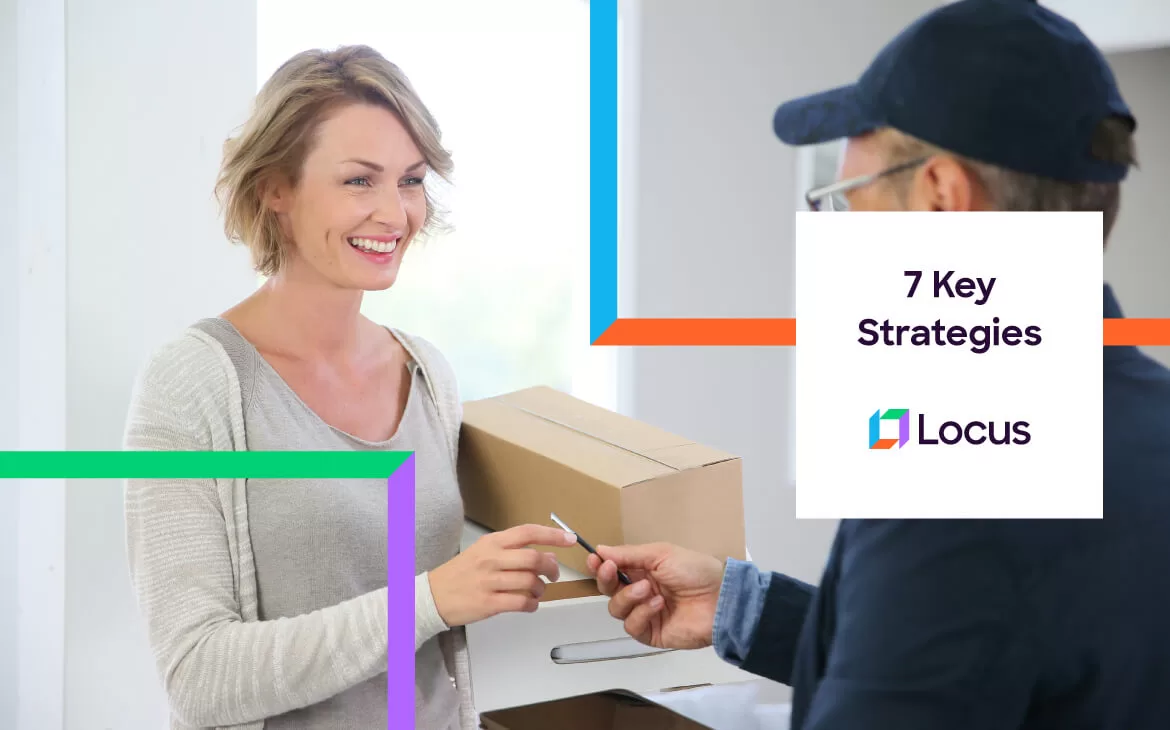E-Commerce, Last Mile Delivery Optimization
7 Key Strategies To Keep Up With Changing Last-mile Customer Expectations
May 25, 2022
7 mins read

“There is only one boss. The customer. And he can fire everybody in the company from the chairman on down, simply by spending his money somewhere else.” –Sam Walton.
The above statement is spot on, largely because of its subtext: Customers spend their money elsewhere because they are not happy with how companies meet their expectations.
And how they have been changing! Take last-mile deliveries for example. During the 2000s, the standard delivery time in the US for an e-commerce order was 8-10 days. Customers will immediately search for the product elsewhere if offered similar timelines today. Same-day and two-day deliveries are now the norms as businesses have successfully adapted to changing consumer expectations over time.
Here are seven key strategies to achieve last mile customer expectations that they have used to make it happen.
1. Use advanced route planning to achieve on-time delivery
The American customer satisfaction index customer experience benchmarks for timeliness of delivery fell drastically from 82 in 2020 to 76 in 2022. – Statista, U.S. consumer shipping companies: Customer experience 2017-2022.
Source: statista.com
When e-commerce was in its infancy, people were more forgiving around meeting delivery times. But today, nothing can be more heartbreaking to a customer than a business breaking its delivery promise on their prized purchases . The most basic thing a customer expects from you is to fulfill their orders on time. Consistently failIng to do so means definitely losing their confidence, which reduces your revenue, and a decline in profitability.
Inefficient routes affect delivery times. The advanced route planning feature in a dispatch management platform factors in real-world constraints for determining the most efficient routes. Some of these include:
- Prediction of traffic restrictions
- Vehicle capacity limitations
- Driver skill sets
- Distance to be covered
- Maximum speed
- Time windows
- Service hours
- Breaks
- Vicinity and so on
Taking real-world constraints and historical inputs into consideration helps you get advanced route planning in place; which in turn helps you provide customers with accurate ETAs. Route planning software enables you to set efficient, accurate, and realistic routes that contribute to high on-time delivery rates.
Looking to improve your on-time delivery rates?
2. Offer high control on the last-mile
The American customer satisfaction index customer experience benchmarks for ease of tracking shipment fell to 81 in 2022 from 83 in 2020 in the US. – Consumer experience with consumer shipping companies in the United States from 2017 to 2022, Statista, 2022.
While shopping at stores, customers would like to feel, touch, and smell the products they buy. It gives them an experience of the product before purchasing. In the same way, by providing customers with real-time tracking capabilities to monitor their order status, you can bring high transparency to the last-mile deliveries, making them feel a lot more involved and valued.
3. Let your customers choose their delivery preferences
48% of respondents consisting of logistics providers, solution providers and retailers stated that the choice of delivery slots was the important wish of customers when it comes to last-mile delivery. – Customers’ wishes on last mile services from retailers 2020. Statista.
Around two decades back, when customers received orders, there were only two options: standard delivery and urgent delivery. Customers did not have the option of rescheduling their order once the parcel was dispatched. But today, the e-commerce revolution has transformed the meaning of convenience in the last mile. Customers want the convenience to choose and reschedule the date, time and destination of deliveries.
Such scheduling gives your operation managers room to set realistic delivery targets for drivers. Also, your drivers would get adequate time to drop off each delivery on time. When your customers choose their timeslot for deliveries, it minimizes the chance of unfulfilled deliveries, which leads to a fall in your reattempted deliveries.
4. Offer free shipping
72% of consumers in the US consider free shipping as the most important criteria for delivery when they land on online shopping websites. -Important delivery criteria in the U.S. 2021, Statista.
The modern customer who lands on an e-commerce website always keeps an eye out for a free shipping option before placing an order. Providing this option can attract new customers and increase the likelihood of repeat business with them.
5. Provide personalized friendly communication
42% of respondents consisting of logistics providers, solution providers, and retailers stated that their customers want real-time updates on delivery. – Customers’ wishes on last-mile services from retailers 2020, Statista.
But does only providing real-time tracking help you win customers? Not quite. Studies have shown that personalized communication contributes to a delightful customer experience and builds brand loyalty.
52% of consumers are likely to switch brands if a company doesn’t make an effort to personalize communications to them. Salesforce Research, State of the Connected Customer.
Just imagine a message like this when you offer a timely notification update on orders.
Hi Joseph! Just letting you know: your order reaches tomorrow between 10 am to 10:30 am. See you soon!
Customers need this kind of personable communication with drivers before the order is delivered. Personalized communication through every completed delivery goes a long way in creating a quality last-mile customer experience.
6. Implement fast shipping with alternative order fulfillment models
90% of consumers see 2 to 3-day delivery as the baseline, and 30% expect same-day delivery. – Retail speaks: Seven imperatives for the US retail industry, Mckinsey, 2020.
64% of US consumers find fast shipping as the second most important criteria when they do online purchases. – Important delivery criteria in the U.S. 2021, Statista.
The increasing demand for fast shipping has accelerated the need for brands to bring inventories closer to customers. The best way to make your last-mile frictionless is by building new delivery fulfillment avenues. Some of them include:
- Buy Online Pick-up In Store (BOPIS)
- Buy Online Ship from Store (BOSS)
- Hyperlocal deliveries
- Micro-fulfillment centers
- Pop-up distribution centers
- Curbside deliveries and
- Dark stores
Building omnichannel fulfillment capabilities lets you minimize delivery time, saving operational costs involved in home deliveries. By turning stores into small fulfillment centers, brands can ensure higher flexibility in order fulfillment.
Find out the role of logistics in omnichannel retail fulfillment
7. Use data insights to understand consumer expectations
How will you know whether the customer is happy with your deliveries? The obvious answer is data. Data has occupied an inevitable space in the last-mile delivery planning and its strategic implementation. Data insights are the magnetic compasses that indicate whether your business is moving in the right direction. Using it, you can find out hidden inefficiencies and rectify them when things take an ugly turn.
Example:
An operation manager manages order fulfillment for two different delivery zones — Zone A and Zone B. She finds out that a majority of same-day deliveries are fulfilled in Zone A, and the majority of three-day deliveries are fulfilled in Zone B.
With the help of these data insights, she understands consumer preferences in two different zones. Combining historical data with machine learning algorithms helps her allocate, plan and manage her fleet effectively. Using customer feedback and last-mile delivery metrics like On-Time In-Full (OTIF), she can find out if customers are receiving satisfying delivery experiences.
Time to bring your strategies into action using a dispatch management platform!
If you have made it this far, you have got a clear idea of what your customers expect from you in the last-mile. And now it is time to take action! Investing in a dispatch management platform gives you a massive edge in meeting and surpassing your changing last-mile consumer preferences.
Locus dispatch management platform has helped many businesses minimize their inefficiencies and establish customer confidence. Its competent artificial intelligence capabilities enable you to effectively plan your deliveries in advance. By helping you schedule deliveries based on last-mile consumer expectations, it contributes to a higher First Attempt Delivery Rates (FADR) for your business.
Want to build a last-mile delivery experience that exceeds your customers’ expectations? Try a demo with Locus now!
Related Tags:

Featured
Locus to Participate in Gartner Supply Chain Symposium/Xpo™ 2022 as Platinum Sponsor
Do visit us at booth #236 from June 6-8 for insights, frameworks and strategies on last-mile logistics optimization We’re excited to announce that Locus will be attending the Supply Chain Symposium/Xpo™ 2022 as a Platinum Sponsor! The symposium, taking place in Orlando, Florida from June 6-8, is arguably one of the most anticipated annual events […]
Read more
Last Mile Delivery Optimization
Solving the Last-Mile Problem With Scalable Logistics Technology
The last-mile problem is so consistent in supply chains across industries. Addressing the last-mile challenges using logistics tech can scale up the businesses.
Read moreMOST POPULAR
EDITOR’S PICKS
SUBSCRIBE TO OUR NEWSLETTER
Stay up to date with the latest marketing, sales, and service tips and news


7 Key Strategies To Keep Up With Changing Last-mile Customer Expectations